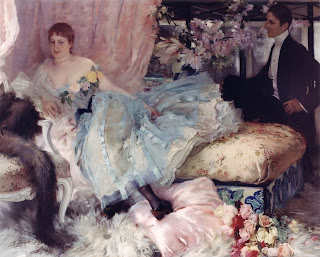William Bouguereau: L'amour et Psyche
William Bouguereau arrived in Paris from the provinces in 1846 at the age of 20; he was determined to build a career as an artist. He immediately joined the atelier of the esteemed painter François-Édouard Picot, and soon after persuaded Picot to recommend him for entry to the École des Beaux-Arts. While he was barely accepted, placing ninety-ninth out of 100 applicants, Bouguereau went on to achieve extraordinary fame and popularity, becoming one of the most critically and commercially successful painters of his day.
By 1899, the year
L'Amour et Psychè was painted, Bouguereau had attained a level of success likely unimaginable for a once quiet boy from a modest family in La Rochelle. He had received countless medals at various juried exhibitions both in France and abroad; secured numerous important public and private commissions; was named professor at the École des Beaux-Arts; and was made Officer of the Légion d'honneur, one of the most prestigious decorations in France. Painted in the last decade of the 19th century,
L'Amour et Psyché embodies the culmination of Bouguereau's long and successful career. It displays his consummate artistic ability, particularly in rendering the human form, where his two protagonists appear as if created by real flesh and bone rather than paint and brush. From a commercial point of view,
L'Amour et Psyché represents Bouguereau's keen understanding of contemporary popular taste, an appreciation which had evolved throughout his career. In fact, this painting is almost the polar opposite of his monumental early masterpiece,
Dante et Virgile aux Enfers from 1850, the type of painting he himself acknowledged would never appeal to the main-stream art buying public.
Our painting is closely related to two other versions of the subject painted earlier in Bouguereau's career. In 1889, he created Psyché et l'Amour, his first life-size version of the mythological lovers as young adults hovering mid-air. That same year he created another version of this subject,
L'Amour et Psyché, enfants, this time depicting the characters as young children resting on, rather than soaring through, the clouds, with Cupid pulling a reluctant Psyche toward him for a kiss. Five years later Bouguereau returned to the theme of the two lovers as young adults, creating
Le ravissement de Psyché (1895), which also features a full-size Cupid and Psyche traveling to Cupid's celestial lair. Bouguereau's repeated return to this subject of young adult lovers featured in a large-scale, full-size format attests to its enduring popularity and the artist's personal satisfaction with his interpretation of it.
The tale of Cupid and Psyche greatly appealed to turn-of-the-century audiences for its obvious themes of love, beauty, jealousy and perseverance; with the ultimate conclusion that love conquers all. As the story goes, Psyche, a young mortal woman of exceptional beauty, drives the powerful goddess of Love, Venus, into a jealous rage. Venus in turn commands her son Cupid to use his famous golden arrow to make Psyche fall eternally in love with a monster. Cupid approaches Psyche in her sleep and, upon seeing her, is too overcome with her beauty, accidentally scratching himself with his arrow. Victim of his own trickery, he falls deeply in love with the human girl. After a complex series of trials and tests created by Venus to destroy Psyche, the young mortal woman prevails and she and Cupid are united in a marriage blessed by Jupiter. Psyche is ultimately transformed into a goddess.
In
L'Amour et Psyché, the two figures are a physical embodiment of the transportive power of love, as Cupid is literally moving Psyche through the air, away from Earthly hardships, and toward a celestial world. Cupid's role as Psyche's protector is reinforced by his lean physical strength and broad, outstretched wings. Psyche, appearing demure in his firm embrace, is often identified by butterfly wings, as her name in Greek literally means "soul" or "butterfly," and she has come to represent the human spirit's ability to emerge from darkness. She is particularly striking in her distinctly feminine physique, which is accentuated by her position in Cupid's arms. The origins of this pose are found in a preparatory drawing (fig.4); it is also interesting to note that Bouguereau's decision to show the back of Psyche rather than the frontal pose of the 1889 and 1895 versions, recalls an earlier motif that he used in his 1884,
L'Etoile perdue. Additionally, Bouguereau worked out the final composition by repeating the two figures in a variety of interchangeable poses on separate sheets of drawings. Once he had settled on the final composition, he made a small, almost "impressionistic" oil sketch to determine his color choices. The last step of the process was to complete a large cartoon on blue paper, close to the scale of the final painting. All of these preparatory works are in a private French collection. [
Sotheby’s]


































